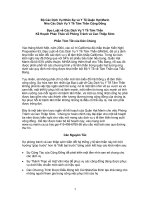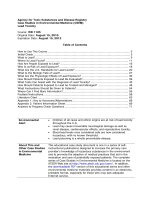U.S. DEPARTMENT OF HEALTH AND HUMAN SERVICES: Public Health Service Agency for Toxic Substances and Disease Registry doc
Bạn đang xem bản rút gọn của tài liệu. Xem và tải ngay bản đầy đủ của tài liệu tại đây (4.05 MB, 497 trang )
TOXICOLOGICAL PROFILE FOR
DDT, DDE, and DDD
U.S. DEPARTMENT OF HEALTH AND HUMAN SERVICES
Public Health Service
Agency for Toxic Substances and Disease Registry
September 2002
ii DDT, DDE, and DDD
DISCLAIMER
The use of company or product name(s) is for identification only and does not imply endorsement by the
Agency for Toxic Substances and Disease Registry.
iii DDT, DDE, and DDD
UPDATE STATEMENT
Toxicological profiles are revised and republished as necessary, but no less than once every three years.
For information regarding the update status of previously released profiles, contact ATSDR at:
Agency for Toxic Substances and Disease Registry
Division of Toxicology/Toxicology Information Branch
1600 Clifton Road NE, E-29
Atlanta, Georgia 30333
V
FOmWORD
This
toxicological profile is prepared in accordance with guidelines* developed by the Agency for
Toxic Substances and Disease Registry (ATSDR) and the Environmental Protection Agency (EPA). The
original guidelines were published in the
Federal
Register
on April 17, 1987. Each profile will be revised
and republished
as
necessary.
The ATSDR toxicological profile succinctly characterizes the toxicologic and adverse health
effects information for the hazardous substance described therein. Each peer-reviewed profile identifies
and reviews the key literature that describes a hazardous substance's toxicologic properties. Other
pertinent literature is also presented, but is described in
less
detail than the key studies. The profile
is
not
intended to be an exhaustive document; however, more comprehensive sources of specialty information
are referenced.
The focus
of the profiles is on health and toxicologic information; therefore, each toxicological
profile begins with a public health statement that describes, in nontechnical language,
a
substance's
reIevant toxicological properties. Following the public health statement
is
information concerning levels
of si,gnificant human exposure and, where
known, significant health effects. The adequacy of
information to determine a substance's health effects is described
in
a health effects
summary.
Data
needs that are of significance to protection of public health are identified by ATSDR and EPA.
Each profile includes the following:
The examination, summary, and interpretation of available toxicologic information and
epidemiologic evaluations on
a
hazardous substance to ascertain the levels of significant
human exposure for the substance and the associated acute, subacute, and chronic health
effects;
A determination
of
whether adequate information on the health effects of each substance is
available or in the process of development to determine levels of exposure that present a
significant risk to human health
of
acute, subacute, and chronic health effects; and
Where appropriate, identification of toxicologic testing needed to identify the types or levels
of exposure that may present significant
risk
of adverse health effects in humans.
principal audiences for the toxicological profiles are health professionals at the federal, state,
and local levels; interested private sector organizations and groups; and members of the public.
This profile reflects ATSDRs assessment of all relevant toxicologic testing and information that
has been peer-reviewed. Staff
of
the Centers for Disease Control and Prevention and other federal
scientists have also reviewed the profile. In addition, this profile has been peer-reviewed by a
nongovernmental panel and was made available for public review. Final responsibility for
the contents
and views expressed in
this
toxicological profile resides with ATSDR.
Administrator
Agency for Toxic Substances and
Disease Registry
vi DDT, DDE, and DDD
*Legislative Background
The toxicological profiles are developed in response to the Superfund Amendments and
Reauthorization Act (SARA) of 1986 (Public law 99-499) which amended the Comprehensive
Environmental Response, Compensation, and Liability Act of 1980 (CERCLA or Superfund). This
public law directed ATSDR to prepared toxicological profiles for hazardous substances most commonly
found at facilities on the CERCLA National Priorities List and that pose the most significant potential
threat to human health, as determined by ATSDR and the EPA. The availability of the revised priority
list of 275 hazardous substances was announced in the Federal Register on November 17, 1997 (62 FR
61332). For prior versions of the list of substances, see Federal Register notices dated April 29, 1996 (61
FR 18744); April 17, 1987 (52 FR 12866); October 20, 1988 (53 FR 41280); October 26, 1989 (54 FR
43619); October 17, 1990 (55 FR 42067); October 17, 1991 (56 FR 52166); October 28, 1992 (57 FR
48801); and February 28, 1994 (59 FR 9486). Section 104(i)(3) of CERCLA, as amended, directs the
Administrator of ATSDR to prepare a toxicological profile for each substance on the list.
vii DDT, DDE, and DDD
QUICK REFERENCE FOR HEALTH CARE PROVIDERS
Toxicological Profiles are a unique compilation of toxicological information on a given hazardous
substance. Each profile reflects a comprehensive and extensive evaluation, summary, and interpretation
of available toxicologic and epidemiologic information on a substance. Health care providers treating
patients potentially exposed to hazardous substances will find the following information helpful for fast
answers to often-asked questions.
Primary Chapters/Sections of Interest
Chapter 1: Public Health Statement: The Public Health Statement can be a useful tool for educating
patients about possible exposure to a hazardous substance. It explains a substance’s relevant
toxicologic properties in a nontechnical, question-and-answer format, and it includes a review of
the general health effects observed following exposure.
Chapter 2: Relevance to Public Health: The Relevance to Public Health Section evaluates, interprets,
and assesses the significance of toxicity data to human health.
Chapter 3: Health Effects: Specific health effects of a given hazardous compound are reported by type
of health effect (death, systemic, immunologic, reproductive), by route of exposure, and by length
of exposure (acute, intermediate, and chronic). In addition, both human and animal studies are
reported in this section.
NOTE: Not all health effects reported in this section are necessarily observed in
the clinical setting. Please refer to the Public Health Statement to identify
general health effects observed following exposure.
Pediatrics: Four new sections have been added to each Toxicological Profile to address child health
issues:
Section 1.6 How Can (Chemical X) Affect Children?
Section 1.7 How Can Families Reduce the Risk of Exposure to (Chemical X)?
Section 3.8 Children’s Susceptibility
Section 6.6 Exposures of Children
Other Sections of Interest:
Section 3.9 Biomarkers of Exposure and Effect
Section 3.12 Methods for Reducing Toxic Effects
ATSDR Information Center
Phone: 1-888-42-ATSDR or (404) 498-0110 Fax: (404) 498-0057
E-mail: Internet:
The following additional material can be ordered through the ATSDR Information Center:
Case Studies in Environmental Medicine: Taking an Exposure History—The importance of taking an
exposure history and how to conduct one are described, and an example of a thorough exposure
history is provided. Other case studies of interest include Reproductive and Developmental
Hazards; Skin Lesions and Environmental Exposures; Cholinesterase-Inhibiting Pesticide
Toxicity; and numerous chemical-specific case studies.
viii DDT, DDE, and DDD
Managing Hazardous Materials Incidents is a three-volume set of recommendations for on-scene
(prehospital) and hospital medical management of patients exposed during a hazardous materials incident.
Volumes I and II are planning guides to assist first responders and hospital emergency department
personnel in planning for incidents that involve hazardous materials. Volume III—Medical Management
Guidelines for Acute Chemical Exposures—is a guide for health care professionals treating patients
exposed to hazardous materials.
Fact Sheets (ToxFAQs) provide answers to frequently asked questions about toxic substances.
Other Agencies and Organizations
The National Center for Environmental Health (NCEH) focuses on preventing or controlling disease,
injury, and disability related to the interactions between people and their environment outside the
workplace. Contact: NCEH, Mailstop F-29, 4770 Buford Highway, NE, Atlanta, GA 30341-
3724 • Phone: 770-488-7000 • FAX: 770-488-7015.
The National Institute for Occupational Safety and Health (NIOSH) conducts research on occupational
diseases and injuries, responds to requests for assistance by investigating problems of health and
safety in the workplace, recommends standards to the Occupational Safety and Health
Administration (OSHA) and the Mine Safety and Health Administration (MSHA), and trains
professionals in occupational safety and health. Contact: NIOSH, 200 Independence Avenue,
SW, Washington, DC 20201 • Phone: 800-356-4674 or NIOSH Technical Information Branch,
Robert A. Taft Laboratory, Mailstop C-19, 4676 Columbia Parkway, Cincinnati, OH 45226-1998
• Phone: 800-35-NIOSH.
The National Institute of Environmental Health Sciences (NIEHS) is the principal federal agency for
biomedical research on the effects of chemical, physical, and biologic environmental agents on
human health and well-being. Contact: NIEHS, PO Box 12233, 104 T.W. Alexander Drive,
Research Triangle Park, NC 27709 • Phone: 919-541-3212.
Referrals
The Association of Occupational and Environmental Clinics (AOEC) has developed a network of clinics
in the United States to provide expertise in occupational and environmental issues. Contact:
AOEC, 1010 Vermont Avenue, NW, #513, Washington, DC 20005 • Phone: 202-347-4976 •
FAX: 202-347-4950 • e-mail: • Web Page:
The American College of Occupational and Environmental Medicine (ACOEM) is an association of
physicians and other health care providers specializing in the field of occupational and
environmental medicine. Contact: ACOEM, 55 West Seegers Road, Arlington Heights, IL
60005 • Phone: 847-818-1800 • FAX: 847-818-9266.
ix DDT, DDE, and DDD
CONTRIBUTORS
CHEMICAL MANAGER(S)/AUTHORS(S):
Obaid Faroon, Ph.D.
M. Olivia Harris, M.A.
ATSDR, Division of Toxicology, Atlanta, GA
Fernando Llados, Ph.D.
Steven Swarts, Ph.D.
Gloria Sage, Ph.D.
Mario Citra, Ph.D.
Daniel Gefell, M.S.
Syracuse Research Corporation, North Syracuse, NY
THE PROFILE HAS UNDERGONE THE FOLLOWING ATSDR INTERNAL REVIEWS:
1. Health Effects Review. The Health Effects Review Committee examines the health effects
chapter of each profile for consistency and accuracy in interpreting health effects and classifying
end points.
2. Minimal Risk Level Review. The Minimal Risk Level Workgroup considers issues relevant to
substance-specific minimal risk levels (MRLs), reviews the health effects database of each
profile, and makes recommendations for derivation of MRLs.
3. Data Needs Review. The Research Implementation Branch reviews data needs sections to assure
consistency across profiles and adherence to instructions in the Guidance.
xi DDT, DDE, and DDD
PEER REVIEW
A peer review panel was assembled for DDT, DDE, and DDD. The panel consisted of the following
members:
1. Dr. D. Andrew Crain, Assistant Professor, Maryville College, Maryville, TN;
2. Dr. Donald Michael Fry, Director, Center for Avian Biology, University of California at Davis;
3. Dr. Christopher Metcalfe, Professor and Chair, Environmental and Resource Studies, Trent
University, Peterborough, Ontario, Canada; and
4. Dr. Mary S. Wolff, Professor of Community Medicine, Mt. Sinai School of Medicine, New York,
NY.
These experts collectively have knowledge of DDT, DDE, and DDD's physical and chemical properties,
toxicokinetics, key health end points, mechanisms of action, human and animal exposure, and
quantification of risk to humans. All reviewers were selected in conformity with the conditions for peer
review specified in Section 104(I)(13) of the Comprehensive Environmental Response, Compensation,
and Liability Act, as amended.
Scientists from the Agency for Toxic Substances and Disease Registry (ATSDR) have reviewed the peer
reviewers' comments and determined which comments will be included in the profile. A listing of the
peer reviewers' comments not incorporated in the profile, with a brief explanation of the rationale for their
exclusion, exists as part of the administrative record for this compound. A list of databases reviewed and
a list of unpublished documents cited are also included in the administrative record.
The citation of the peer review panel should not be understood to imply its approval of the profile's final
content. The responsibility for the content of this profile lies with the ATSDR.
xiii DDT, DDE, and DDD
CONTENTS
FOREWORD v
QUICK REFERENCE FOR HEALTH CARE PROVIDERS vii
CONTRIBUTORS ix
PEER REVIEW xi
LIST OF FIGURES xvii
LIST OF TABLES xix
1. PUBLIC HEALTH STATEMENT 1
1.1 WHAT ARE DDT, DDE, AND DDD? 2
1.2 WHAT HAPPENS TO DDT, DDE, AND DDD WHEN THEY ENTER THE
ENVIRONMENT? 2
1.3 HOW MIGHT I BE EXPOSED TO DDT, DDE, AND DDD? 4
1.4 HOW CAN DDT, DDE, AND DDD ENTER AND LEAVE MY BODY? 5
1.5 HOW CAN DDT, DDE, AND DDD AFFECT MY HEALTH? 6
1.6 HOW CAN DDT, DDE, AND DDD AFFECT CHILDREN? 8
1.7 HOW CAN FAMILIES REDUCE THE RISK OF EXPOSURE TO DDT, DDE, AND
DDD? 10
1.8 IS THERE A MEDICAL TEST TO DETERMINE WHETHER I HAVE BEEN
EXPOSED TO DDT, DDE, AND DDD? 11
1.9 WHAT RECOMMENDATIONS HAS THE FEDERAL GOVERNMENT MADE TO
PROTECT HUMAN HEALTH? 11
1.10 WHERE CAN I GET MORE INFORMATION? 13
2. RELEVANCE TO PUBLIC HEALTH 15
2.1 BACKGROUND AND ENVIRONMENTAL EXPOSURES TO DDT/DDE/DDD IN
THE UNITED STATES 15
2.2 SUMMARY OF HEALTH EFFECTS 19
2.3 MINIMAL RISK LEVELS 27
3. HEALTH EFFECTS 33
3.1 INTRODUCTION 33
3.2 DISCUSSION OF HEALTH EFFECTS BY ROUTE OF EXPOSURE 34
3.2.1 Inhalation Exposure 35
3.2.1.1 Death 36
3.2.1.2 Systemic Effects 36
3.2.1.3 Immunological and Lymphoreticular Effects 37
3.2.1.4 Neurological Effects 37
3.2.1.5 Reproductive Effects 37
3.2.1.6 Developmental Effects 37
3.2.1.7 Cancer 37
3.2.2 Oral Exposure 37
xiv DDT, DDE, and DDD
3.2.2.1 Death 72
3.2.2.2 Systemic Effects 74
3.2.2.3 Immunological and Lymphoreticular Effects 86
3.2.2.4 Neurological Effects 90
3.2.2.5 Reproductive Effects 93
3.2.2.6 DevelopmentalEffects 99
3.2.2.7 Cancer 107
3.2.3 Dermal Exposure 126
3.2.3.1 Death 127
3.2.3.2 SystemicEffects 127
3.2.3.3 Immunological and Lymphoreticular Effects 128
3.2.3.4 NeurologicalEffects 129
3.2.3.5 Reproductive Effects 129
3.2.3.6 DevelopmentalEffects 129
3.2.3.7 Cancer 129
3.3 GENOTOXICITY 129
3.4 HEALTH EFFECTS IN WILDLIFE POTENTIALLY RELEVANT TO HUMAN
HEALTH 133
3.5 TOXICOKINETICS 138
3.5.1 Absorption 139
3.5.1.1 Inhalation Exposure 139
3.5.1.2 Oral Exposure 139
3.5.1.3 Dermal Exposure 140
3.5.2 Distribution 140
3.5.3 Metabolism 143
3.5.4 EliminationandExcretion 149
3.5.5 Physiologically Based Pharmacokinetic (PBPK)/Pharmacodynamic (PD)
Models 151
3.6 MECHANISMS OF ACTION 160
3.6.1 PharmacokineticMechanisms 160
3.6.2 MechanismsofToxicity 161
3.6.3 Animal-to-HumanExtrapolations 176
3.7 TOXICITIES MEDIATED THROUGH THE NEUROENDOCRINE AXIS 176
3.8 CHILDREN’S SUSCEPTIBILITY 180
3.9 BIOMARKERS OF EXPOSURE AND EFFECT
187
3.9.1 Biomarkers Used to Identify or Quantify Exposure to DDT, DDE, and
DDD 188
3.9.2 Biomarkers Used to Characterize Effects Caused by DDT, DDE, and
DDD 190
3.10 INTERACTIONSWITHOTHERCHEMICALS 191
3.11 POPULATIONS THAT ARE UNUSUALLY SUSCEPTIBLE 193
3.12 METHODS FOR REDUCING TOXIC EFFECTS 193
3.12.1 Reducing Peak Absorption Following Exposure 194
3.12.2 ReducingBodyBurden 194
3.12.3 InterferingwiththeMechanismofActionforToxicEffects 195
3.13 ADEQUACY OF THE DATABASE 196
3.13.1 ExistingInformationonHealthEffectsofDDT,DDE,andDDD 196
3.13.2 IdentificationofDataNeeds 199
3.13.3 Ongoing Studies 210
4. CHEMICAL AND PHYSICAL INFORMATION 215
xv DDT, DDE, and DDD
4.1 CHEMICALIDENTITY 215
4.2 PHYSICAL AND CHEMICAL PROPERTIES 215
5. PRODUCTION, IMPORT/EXPORT, USE, AND DISPOSAL 221
5.1 PRODUCTION 221
5.2 IMPORT/EXPORT 222
5.3 USE 222
5.4 DISPOSAL 223
6. POTENTIALFORHUMANEXPOSURE 225
6.1 OVERVIEW 225
6.2 RELEASES TO THE ENVIRONMENT 230
6.2.1 Air 230
6.2.2 Water 230
6.2.3 Soil 231
6.3 ENVIRONMENTALFATE 232
6.3.1 Transport and Partitioning 232
6.3.2 TransformationandDegradation 237
6.3.2.1 Air 237
6.3.2.2 Water 237
6.3.2.3 SedimentandSoil 238
6.4 LEVELS MONITORED OR ESTIMATED IN THE ENVIRONMENT 241
6.4.1 Air 241
6.4.2 Water 244
6.4.3 SedimentandSoil 246
6.4.4 OtherEnvironmentalMedia 251
6.5 GENERAL POPULATION AND OCCUPATIONAL EXPOSURE 263
6.6 EXPOSURESOFCHILDREN 278
6.7 POPULATIONSWITHPOTENTIALLYHIGHEXPOSURES 279
6.8 ADEQUACY OF THE DATABASE 281
6.8.1 IdentificationofDataNeeds 281
6.8.2 Ongoing Studies 284
7. ANALYTICAL METHODS 287
7.1 BIOLOGICALMATERIALS 287
7.2 ENVIRONMENTAL SAMPLES
291
7.3 ADEQUACY OF THE DATABASE 296
7.3.1 IdentificationofDataNeeds 297
7.3.2 Ongoing Studies 298
8. REGULATIONS AND ADVISORIES 299
9. REFERENCES 309
10. GLOSSARY 397
APPENDICES
A. ATSDR MINIMAL RISK LEVELS AND WORKSHEETS A-1
DDT, DDE, and DDD xvi
B. USER’S GUIDE B-1
C. ACRONYMS, ABBREVIATIONS, AND SYMBOLS C-1
D. HEALTH EFFECTS IN WILDLIFE POTENTIALLY RELEVANT TO HUMAN
HEALTH D-1
E. INDEX E-1
xvii DDT, DDE, and DDD
LIST OF FIGURES
3-1. Levels of Significant Exposure to DDT, DDE, and DDD (except o,p’ isomers) - Oral 59
3-2. Levels of Significant Exposure to o,p’-DDT, DDE, and DDD - Oral 69
3-3a. Model I Metabolic Scheme for DDT 147
3-3b. Model II Metabolic Scheme for DDT 148
3-4. Proposed Metabolic Pathway for the Conversion of p,p’-DDE to its Methylsulfone
Derivative 152
3-5. Conceptual Representation of a Physiologically Based Pharmacokinetic (PBPK) Model for a
Hypothetical Chemical Substance 158
3-6. Diagrammatic Representation of the PBPK Model for Gestation 159
3-7. Diagrammatic Representation of the PBPK Model for the Lactating Dam and Nursing Pup 160
3-8. Existing Information of Health Effects of DDT, DDE, and DDD 201
6-1. Frequency of NPL Sites with DDT, DDE, and DDD Contamination 233
xix DDT, DDE, and DDD
LIST OF TABLES
3-1. Levels of Significant Exposure to DDT, DDE, or DDD (except o,p’ isomers) - Oral 38
3-2. Levels of Significant Exposure to o,p’-DDT, DDE, and DDD - Oral 65
3-3. Genotoxicity of DDT, DDE, and DDD In Vivo 132
3-4. Genotoxicity of DDT, DDE, and DDD In Vitro 133
3-5. Tissue:Blood Partition Coefficients and Pharmacokinetic Constants for Modeling DDE
Disposition in the Pregnant Rat 156
3-6. Physiological Constants Used in the PBPK Model for the Lactating Dam and the Nursing
Pup 157
3-7. Ongoing Studies on the Health Effects of DDT and DDT Analogues 215
4-1. Chemical Identity of p,p'- and o,p'-DDT, DDE, and DDD 220
4-2. Physical and Chemical Properties of p,p'- and o,p'-DDT, DDE, and DDD 222
6-1. Concentrations of DDT and Metabolites in Biota 260
6-2. Average Residues in Food Groups and Average Daily Intake from U.S. FDA Total Diet
Studies 265
6-3. Mean Daily Intake of DDT Per Unit Body Weight (µg/kg body weight/day) for Various Age
Groups in the United States 269
6-4. Levels of DDT Compounds in Human Milk, Blood, and Tissues — Recent Studies 273
7-1. Analytical Methods for Determining DDT, DDE, and DDD in Biological Samples 292
7-2. Analytical Methods for Determining DDT, DDE, and DDD in Environmental Samples 296
8-1. Regulations and Guidelines Applicable to DDT/DDE/DDD 304
1 DDT, DDE, and DDD
1. PUBLIC HEALTH STATEMENT
This public health statement tells you about DDT, DDE, and DDD and the effects of exposure.
The Environmental Protection Agency (EPA) identifies the most serious hazardous waste sites in
the nation. These sites make up the National Priorities List (NPL) and are the sites targeted for
long-term federal cleanup activities. DDT, DDE, and DDD have been found in at least 442 of
the 1,613 current or former NPL sites. However, the total number of NPL sites evaluated for
these substances is not known. As more sites are evaluated, the sites at which DDT, DDE, and
DDD are found may increase. This information is important because exposure to these
substances may harm you and because these sites may be sources of exposure.
When a substance is released from a large area, such as an industrial plant, or from a container,
such as a drum or bottle, it enters the environment. This release does not always lead to
exposure. You are exposed to a substance only when you come in contact with it. You may be
exposed by breathing, eating, or drinking the substance, or by skin contact.
If you are exposed to DDT, DDE, and DDD, many factors determine whether you’ll be harmed.
These factors include the dose (how much), the duration (how long), and how you come in
contact with them. You must also consider the other chemicals you’re exposed to and your age,
sex, diet, family traits, lifestyle, and state of health.
While this document is specifically focused on the primary forms or isomers of DDT, DDE, and
DDD (namely p,p’-DDT, p,p’-DDE, and p,p’-DDD), other isomers of these compounds will be
discussed when appropriate. In some cases, the term DDT will be used to refer to the collection
of all forms of DDT, DDE, and DDD. Should this not be clear from the context, the term ΣDDT
(Σ is used to mean sum of) will be used.
2 DDT, DDE, and DDD
1. PUBLIC HEALTH STATEMENT
1.1 WHAT ARE DDT, DDE, AND DDD?
DDT (1,1,1-trichloro-2,2-bis(p-chlorophenyl)ethane) is a pesticide that was once widely used to
control insects on agricultural crops and insects that carry diseases like malaria and typhus, but is
now used in only a few countries to control malaria. Technical-grade DDT is a mixture of three
forms, p,p’-DDT (85%), o,p’-DDT (15%), and o,o’-DDT (trace amounts). All of these are
white, crystalline, tasteless, and almost odorless solids. Technical grade DDT may also contain
DDE (1,1-dichloro-2,2-bis(p-chlorophenyl)ethylene) and DDD (1,1-dichloro-2,2-bis(p-chloro-
phenyl)ethane) as contaminants. DDD was also used to kill pests, but to a far lesser extent than
DDT. One form of DDD (o,p’-DDD) has been used medically to treat cancer of the adrenal
gland. Both DDE and DDD are breakdown products of DDT.
DDT does not occur naturally in the environment. After 1972, the use of DDT was no longer
permitted in the United States except in cases of a public health emergency. It is, however, still
used in some other areas of the world, most notably for controlling malaria. The use of DDD to
kill pests has also been banned in the United States.
You will find further information on the physical properties and uses of DDT, DDE, and DDD in
Chapters 4 and 5 of this profile.
1.2 WHAT HAPPENS TO DDT, DDE, AND DDD WHEN THEY ENTER THE
ENVIRONMENT?
Before 1973 when it was banned, DDT entered the air, water, and soil during its production and
use as an insecticide. DDT is present at many waste sites, including NPL sites; releases from
these sites might continue to contaminate the environment. Most DDT in the environment is a
result of past use; DDD was also used as a pesticide to a limited extent in the past. DDT still
enters the environment because of its current use in other areas of the world. DDE is only found
in the environment as a result of contamination or breakdown of DDT. DDD also enters the
environment during the breakdown of DDT.
3 DDT, DDE, and DDD
1. PUBLIC HEALTH STATEMENT
Large amounts of DDT were released into the air and on soil or water when it was sprayed on
crops and forests to control insects. DDT was also sprayed in the environment to control
mosquitos. Although the use of DDT is no longer permitted in the United States, DDT may be
released into the atmosphere in other countries where it is still manufactured and used, including
Mexico. DDT, DDE and DDD may also enter the air when they evaporate from contaminated
water and soil. DDT, DDE, and DDD in the air will then be deposited on land or surface water.
This cycle of evaporation and deposition may be repeated many times. As a result, DDT, DDE,
and DDD can be carried long distances in the atmosphere. These chemicals have been found in
bogs, snow, and animals in the Arctic and Antarctic regions, far from where they were ever used.
Some DDT may have entered the soil from waste sites. DDT, DDE, and DDD may occur in the
atmosphere as a vapor or be attached to solids in air. Vapor phase DDT, DDE, and DDD may
break down in the atmosphere due to reactions caused by the sun. The half-life of these
chemicals in the atmosphere as vapors (the time it takes for one-half of the chemical to turn into
something else) has been calculated to be approximately 1.5–3 days. However, in reality, this
half-life estimate is too short to account for the ability of DDT, DDE, and DDD to be carried
long distances in the atmosphere.
DDT, DDE, and DDD last in the soil for a very long time, potentially for hundreds of years.
Most DDT breaks down slowly into DDE and DDD, generally by the action of microorganisms.
These chemicals may also evaporate into the air and be deposited in other places. They stick
strongly to soil, and therefore generally remain in the surface layers of soil. Some soil particles
with attached DDT, DDE, or DDD may get into rivers and lakes in runoff. Only a very small
amount, if any, will seep into the ground and get into groundwater. The length of time that DDT
will last in soil depends on many factors including temperature, type of soil, and whether the soil
is wet. DDT lasts for a much shorter time in the tropics where the chemical evaporates faster
and where microorganisms degrade it faster. DDT disappears faster when the soil is flooded or
wet than when it is dry. DDT disappears faster when it initially enters the soil. Later on,
evaporation slows down and some DDT moves into spaces in the soil that are so small that
microorganisms cannot reach the DDT to break it down efficiently. In tropical areas, ΣDDT
may disappear in much less than a year. In temperate areas, half of the ΣDDT initially present
4 DDT, DDE, and DDD
1. PUBLIC HEALTH STATEMENT
usually disappears in about 5 years. However, in some cases, half of the ΣDDT initially present
will remain for 20, 30, or more years.
In surface water, DDT will bind to particles in the water, settle, and be deposited in the sediment.
DDT is taken up by small organisms and fish in the water. It accumulates to high levels in fish
and marine mammals (such as seals and whales), reaching levels many thousands of times higher
than in water. In these animals, the highest levels of DDT are found in their adipose tissue.
DDT in soil can also be absorbed by some plants and by the animals or people who eat those
crops.
More information about what happens to DDT, DDE, and DDD in the environment can be found
in Chapter 6.
1.3 HOW MIGHT I BE EXPOSED TO DDT, DDE, AND DDD?
People in the United States are exposed to DDT, DDE, and DDD mainly by eating foods
containing small amounts of these compounds. Although not common today, exposure to DDT
could also occur through inhalation or absorption through the skin during the handling or
application of DDT. Even though DDT has not been used in this country since 1972, soil may
still contain some DDT that may be taken up by plants and eaten by animals and people. DDT
from contaminated water and sediment may be taken up by fish. The amount of DDT in food
has greatly decreased since DDT was banned and should continue to decline. In the years 1986
to 1991, the average adult in the United States consumed an average of 0.8 micrograms (a
microgram is a millionth of a gram) of DDT a day. Adults consumed slightly different amounts
based on their age and sex. The largest fraction of DDT in a person’s diet comes from meat,
poultry, dairy products, and fish, including the consumption of sport fish. Leafy vegetables
generally contain more DDT than other vegetables, possibly because DDT in the air is deposited
on the leaves. Infants may be exposed by drinking breast milk.
DDT or its breakdown products are still present in some air, water, and soil samples. However,
levels in most air and water samples are presently so low that exposure is of little concern. DDT
5 DDT, DDE, and DDD
1. PUBLIC HEALTH STATEMENT
levels in air have declined to such low levels that it often cannot be detected. In cases where
DDT has been detected in air, it is associated with air masses coming from regions where DDT
is still used or from the evaporated DDT from contaminated water or soil. p,p’-DDT and p,p’-
DDE concentrations measured in air in the Great Lakes region in 1990 reached maximum levels
of 0.035 and 0.119 nanograms (a nanogram is a billionth of a gram) of chemical per cubic meter
of air (ng/m
3
), respectively. Levels were generally much lower, especially during the winter
months. In 1995–1996, soils in the corn belt, where DDT was heavily used in the past,
contained on the average about 10 nanograms of DDT in a gram of soil. In recent years, most
surface water has not contained detectable amounts of DDT.
People who work or live around NPL sites or work with contaminated soil or sediment would
most likely be exposed by accidentally swallowing soil, having skin contact with the soil,
inhaling DDT vapor, or breathing in DDT in dust.
You can find more information on exposure to DDT, DDE, and DDD in Chapter 6 of this profile.
1.4 HOW CAN DDT, DDE, AND DDD ENTER AND LEAVE MY BODY?
Today in the United States, DDT, DDE, or DDD enters the body mainly when a person eats
contaminated food. The actual amounts of DDT, DDE, and DDD absorbed from foods depends
on both the concentration of chemical in the food and the amount of food eaten. Small amounts
of DDT, DDE, and DDD may also be breathed in and absorbed into the body. DDT, DDE, and
DDD are often attached to particles too large to pass very far into the lungs after air containing
them is breathed. These particles are more likely to be carried upward in the mucus of the air
passages and swallowed than for the DDT to be absorbed in the lungs. DDT, DDE, and DDD do
not enter the body through the skin very easily.
Once inside the body, DDT can break down to DDE or DDD. DDE and DDD, in turn, break
down to other substances (called metabolites). DDT, DDE, and DDD are stored most readily in
fatty tissue, especially DDE. Some of these stored amounts leave the body very slowly. Levels
in fatty tissues may either remain relatively the same over time or even increase with continued









